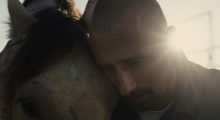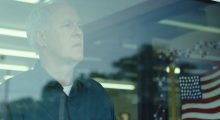Sundance Responses
-
The Sundance Question: What Prop or Piece of Set Decoration is Particularly Integral to Your Film?

Each year Filmmaker asks all the incoming feature directors at Sundance one question. (To see past years’ questions and responses, click here.) This year’s question: Whether capturing or creating a world, the objects onscreen tell as much of a story as the people within it. Whether sourced or accidental, insert shot or background detail, what prop or piece of set decoration do you find particularly integral to your film? What story does it tell? (Check back daily during the festival — new answers are uploaded each day throughout the festival.) “It is An Object That Should Not Belong to That World”: Maite […]
-
“We Decided to Start Editing from Scratch”: Co-Writer/Editor Don Bernier on Always in Season

For her feature debut, Jacqueline Olive examines the death of Lennon Lacy, a black 17-year-old who was found hanging from a swing set in his North Carolina home town. Though his death was quickly ruled a suicide by the authorities, his mother, Claudia, was understandably suspicious, given America’s long, far from resolved history of racialized violence. Editor and co-writer Don Bernier (whose recent credits include Charm City) spoke via email about how he worked on the project, which he first learned of in 2014 but didn’t officially join until last year. Filmmaker: How and why did you wind up being the editor […]
-
“Either There is a Film or There is None. We Chose the Former”: Director Kirill Mikhanovsky | Give Me Liberty

Whenever directors watch their own films, they always do so with the knowledge that there are moments that occurred during their production — whether that’s in the financing and development or shooting or post — that required incredible ingenuity, skill, planning or just plain luck, but whose difficulty is invisible to most spectators. These are the moments directors are often the most proud of, and that pride comes with the knowledge that no one on the outside could ever properly appreciate what went into them. So, we ask: “What hidden part of your film are you most privately proud of […]
-
“The Balanced Amount of Male and Female Crew Working Together”: Directors Bert&Bertie | Troop Zero

Whenever directors watch their own films, they always do so with the knowledge that there are moments that occurred during their production — whether that’s in the financing and development or shooting or post — that required incredible ingenuity, skill, planning or just plain luck, but whose difficulty is invisible to most spectators. These are the moments directors are often the most proud of, and that pride comes with the knowledge that no one on the outside could ever properly appreciate what went into them. So, we ask: “What hidden part of your film are you most privately proud of […]
-
“The Miracle of Securing the Prison Location”: Director Laure de Clermont-Tonnerre | The Mustang

Whenever directors watch their own films, they always do so with the knowledge that there are moments that occurred during their production — whether that’s in the financing and development or shooting or post — that required incredible ingenuity, skill, planning or just plain luck, but whose difficulty is invisible to most spectators. These are the moments directors are often the most proud of, and that pride comes with the knowledge that no one on the outside could ever properly appreciate what went into them. So, we ask: “What hidden part of your film are you most privately proud of […]
-
“We Freed Ourselves from Conventional Documentary Ethics”: Directors Alex Rivera and Cristina Ibarra | The Infiltrators

Whenever directors watch their own films, they always do so with the knowledge that there are moments that occurred during their production — whether that’s in the financing and development or shooting or post — that required incredible ingenuity, skill, planning or just plain luck, but whose difficulty is invisible to most spectators. These are the moments directors are often the most proud of, and that pride comes with the knowledge that no one on the outside could ever properly appreciate what went into them. So, we ask: “What hidden part of your film are you most privately proud of […]
-
“Cram Ten Episodes into Ten Packed Days of Filming”: Series Creator and Star Samantha Jayne | Quarter Life Poetry

Whenever directors watch their own films, they always do so with the knowledge that there are moments that occurred during their production — whether that’s in the financing and development or shooting or post — that required incredible ingenuity, skill, planning or just plain luck, but whose difficulty is invisible to most spectators. These are the moments directors are often the most proud of, and that pride comes with the knowledge that no one on the outside could ever properly appreciate what went into them. So, we ask: “What hidden part of your film are you most privately proud of […]
-
“Teleportation Into the Rich Cultural Space of a Remarkable People”: Director Chiwetel Ejiofor | The Boy Who Harnessed The Wind

Whenever directors watch their own films, they always do so with the knowledge that there are moments that occurred during their production — whether that’s in the financing and development or shooting or post — that required incredible ingenuity, skill, planning or just plain luck, but whose difficulty is invisible to most spectators. These are the moments directors are often the most proud of, and that pride comes with the knowledge that no one on the outside could ever properly appreciate what went into them. So, we ask: “What hidden part of your film are you most privately proud of […]
-
“We Had Over 200 Special Effects”: Director Noble Jones | Tomorrow Man

Whenever directors watch their own films, they always do so with the knowledge that there are moments that occurred during their production — whether that’s in the financing and development or shooting or post — that required incredible ingenuity, skill, planning or just plain luck, but whose difficulty is invisible to most spectators. These are the moments directors are often the most proud of, and that pride comes with the knowledge that no one on the outside could ever properly appreciate what went into them. So, we ask: “What hidden part of your film are you most privately proud of […]
-
“We Had Less than Two Hours”: Creator, Writer and Star Danielle Uhlarik | Bootstrapped

Whenever directors watch their own films, they always do so with the knowledge that there are moments that occurred during their production — whether that’s in the financing and development or shooting or post — that required incredible ingenuity, skill, planning or just plain luck, but whose difficulty is invisible to most spectators. These are the moments directors are often the most proud of, and that pride comes with the knowledge that no one on the outside could ever properly appreciate what went into them. So, we ask: “What hidden part of your film are you most privately proud of […]










